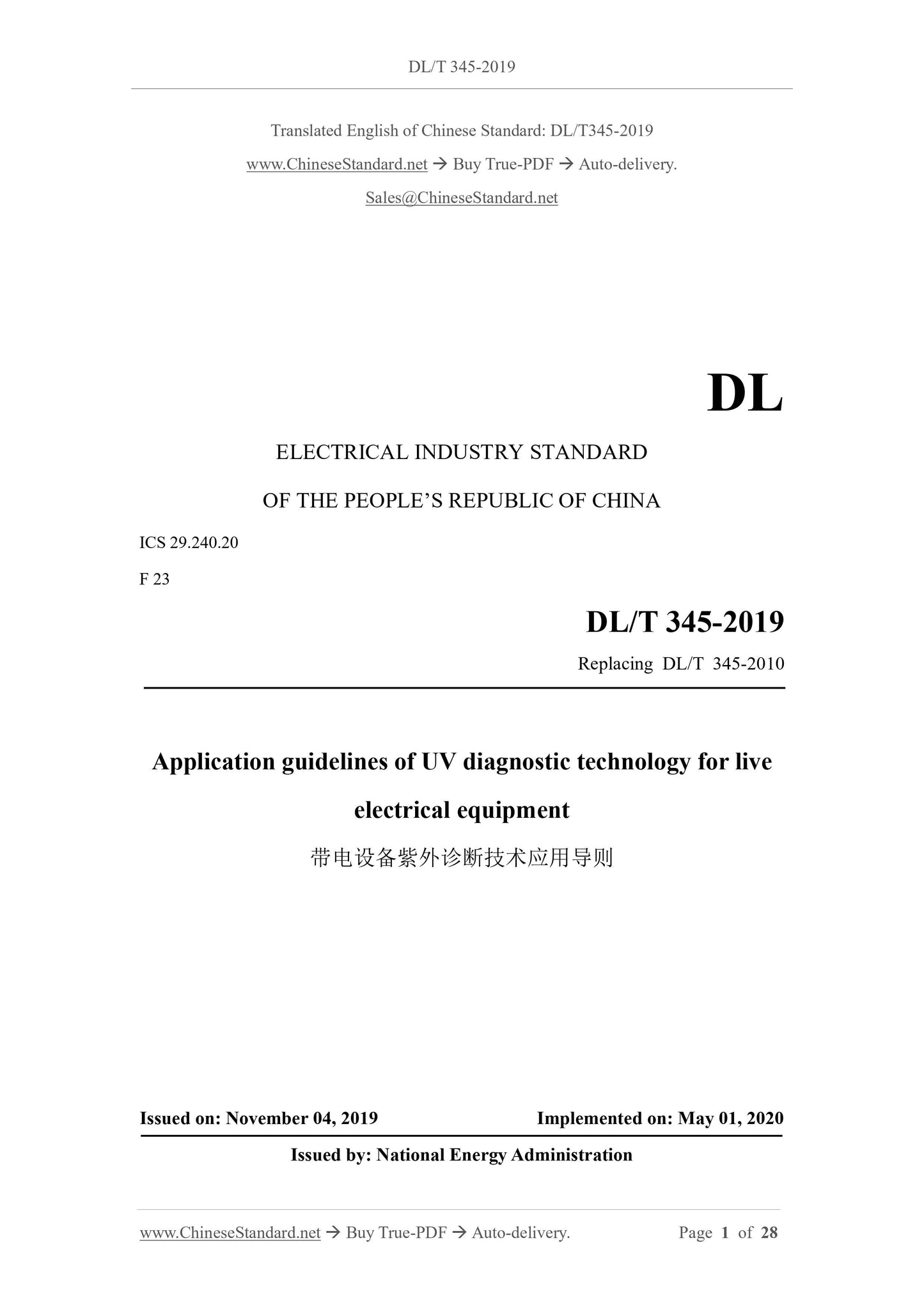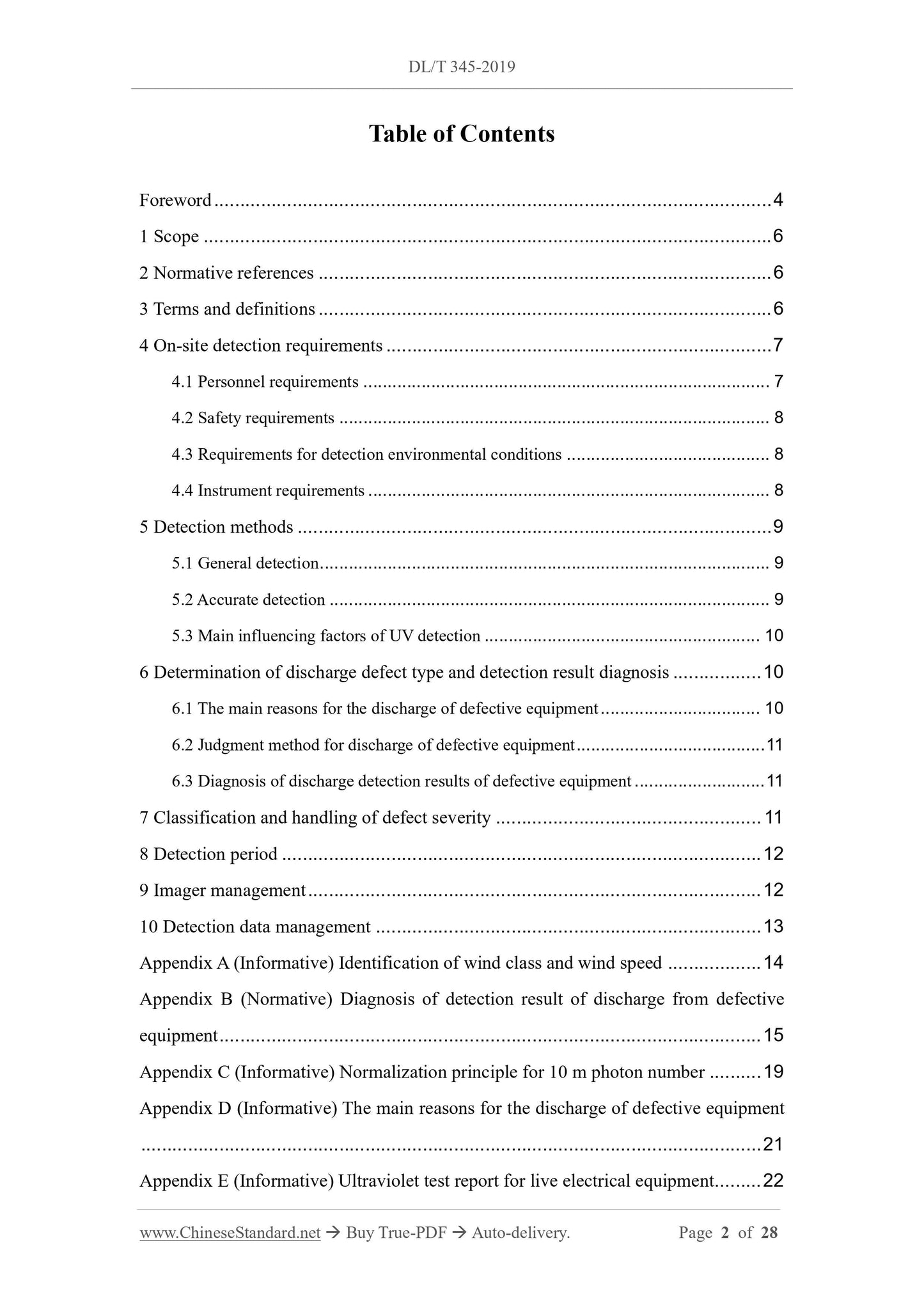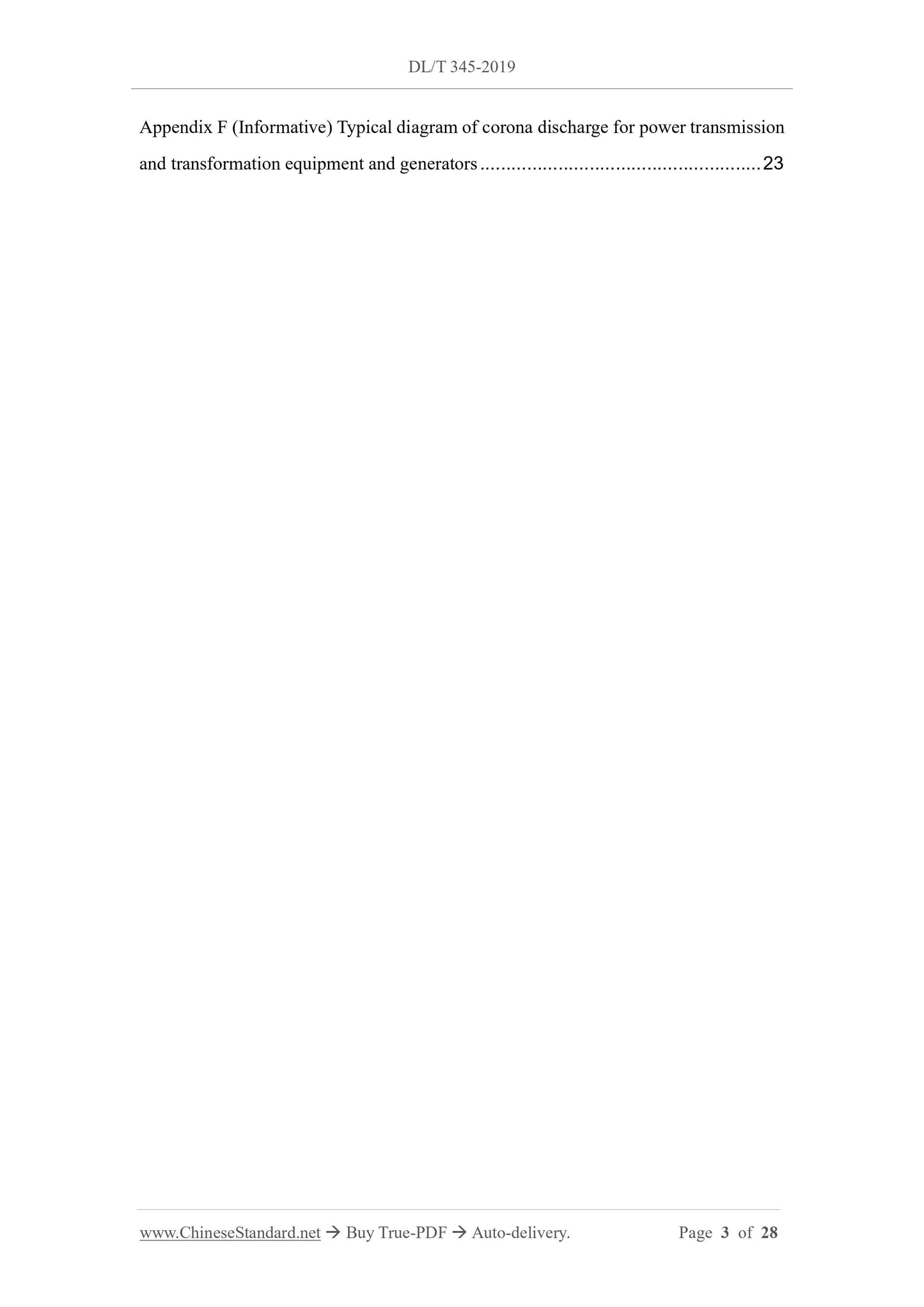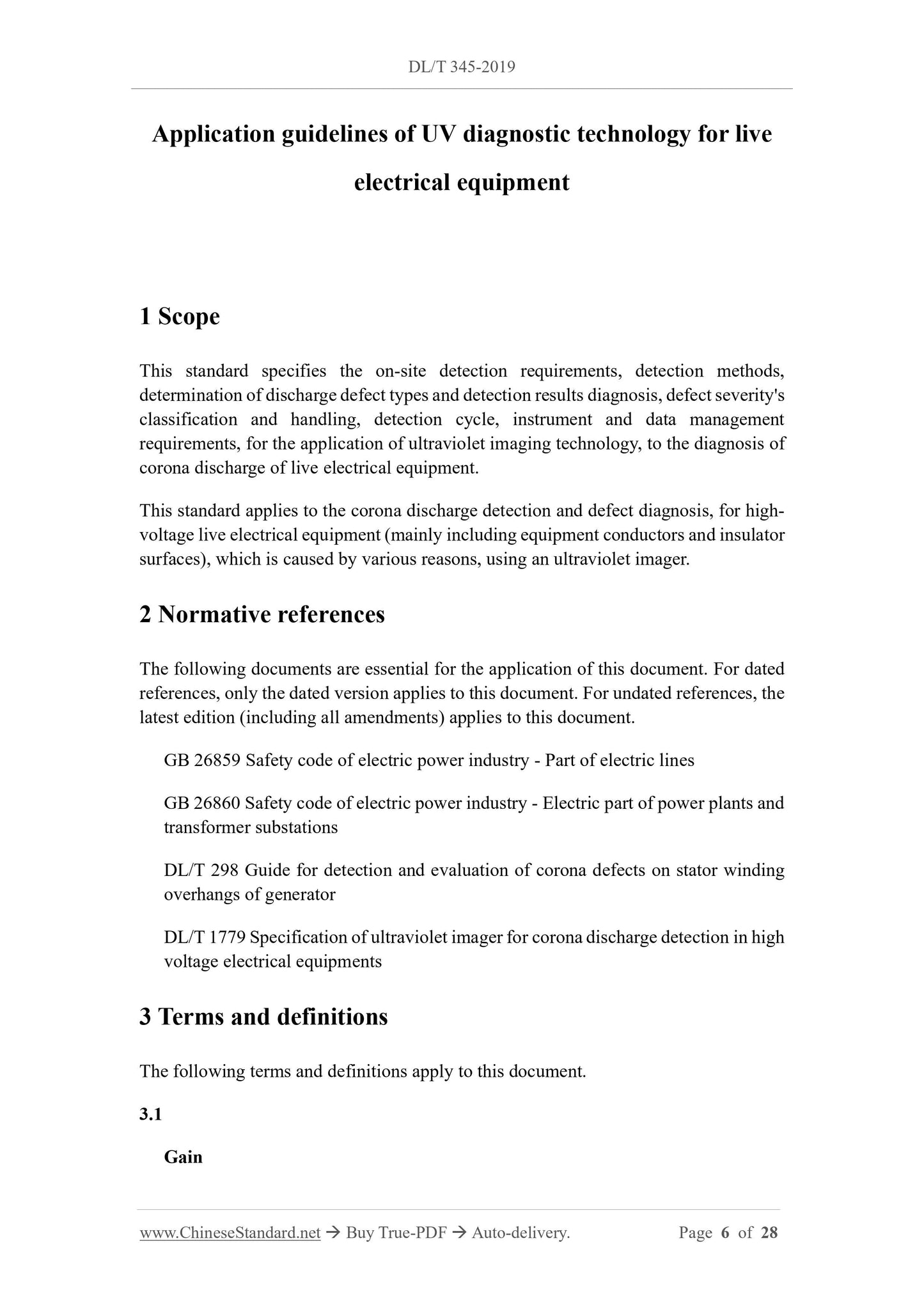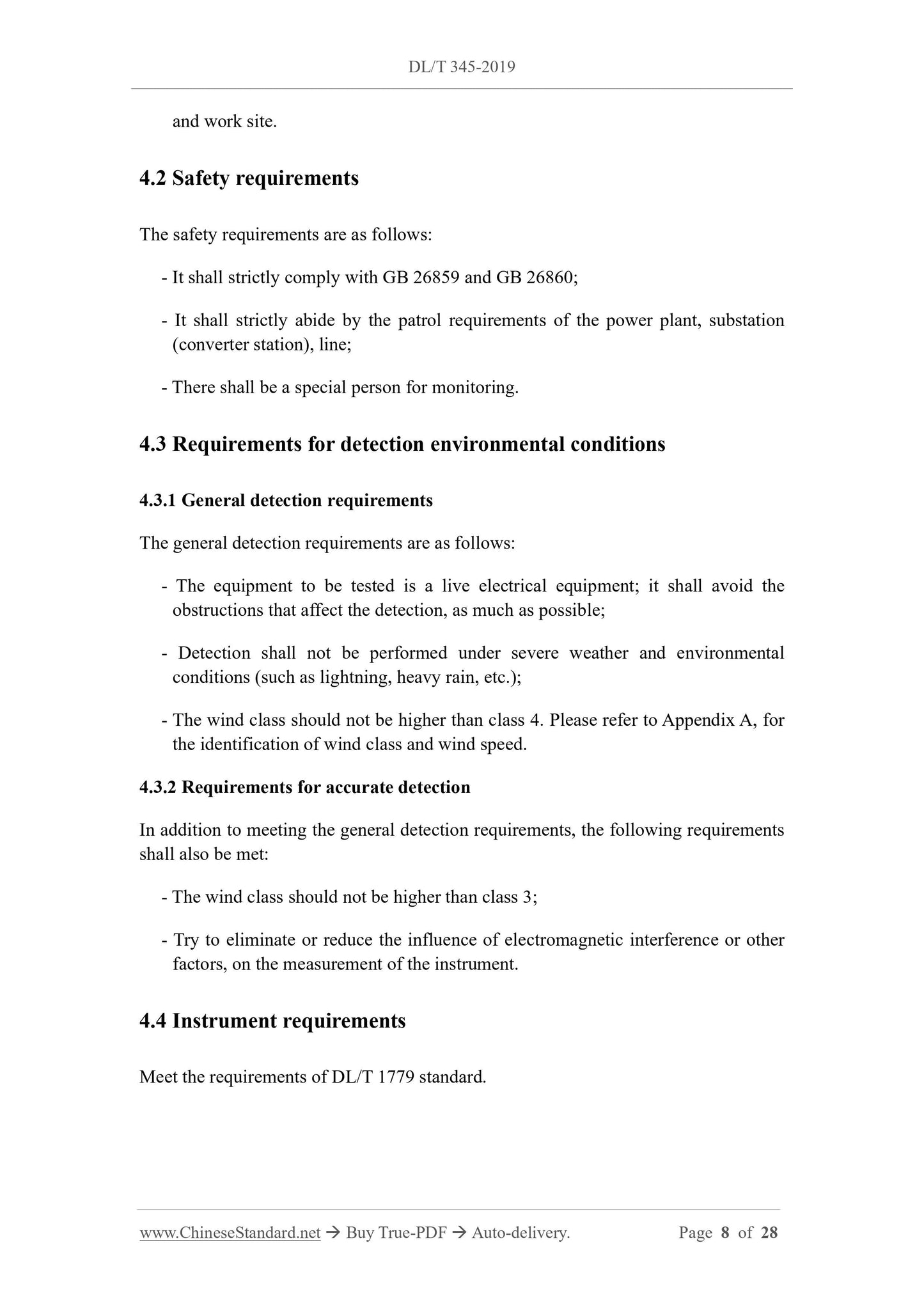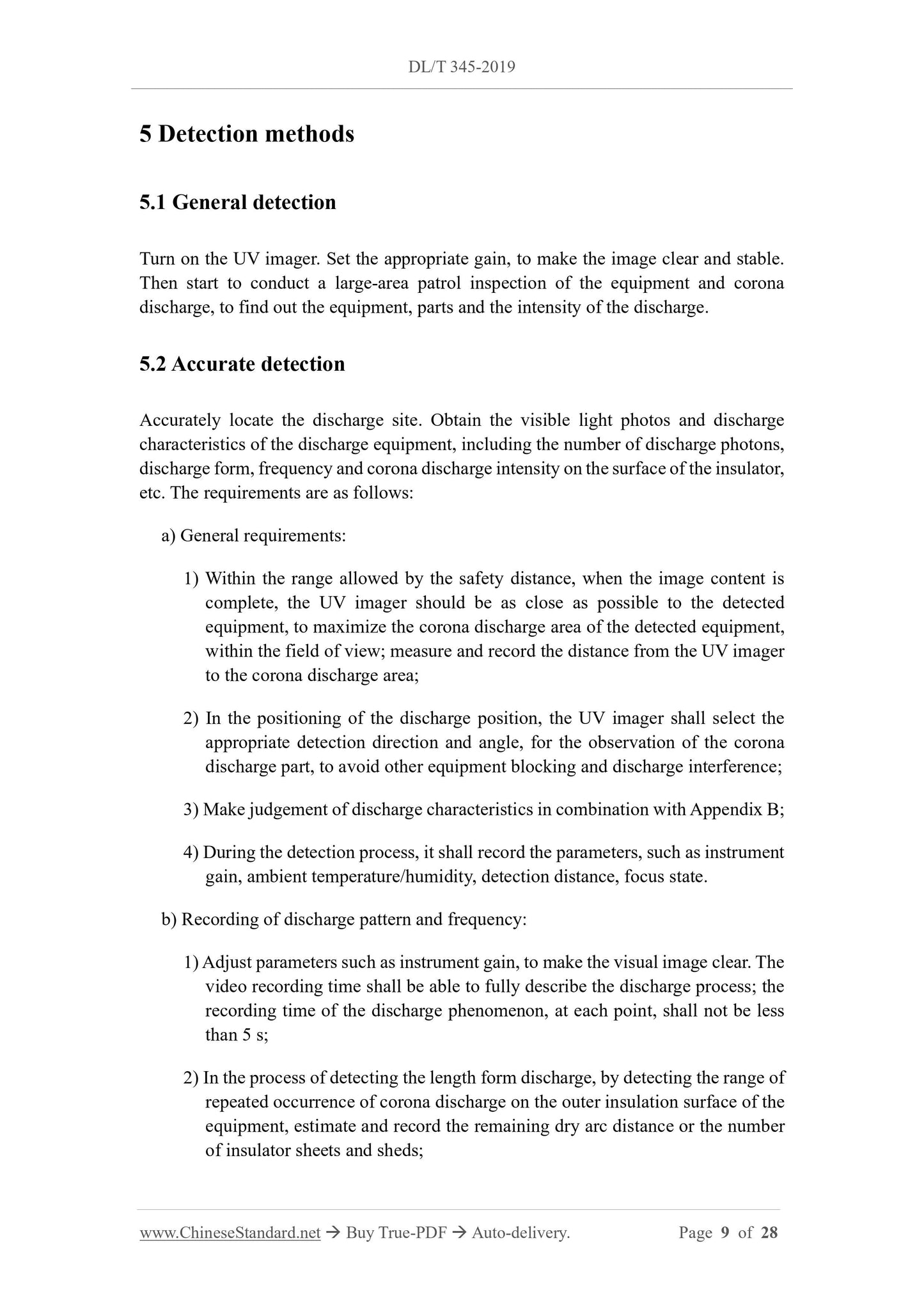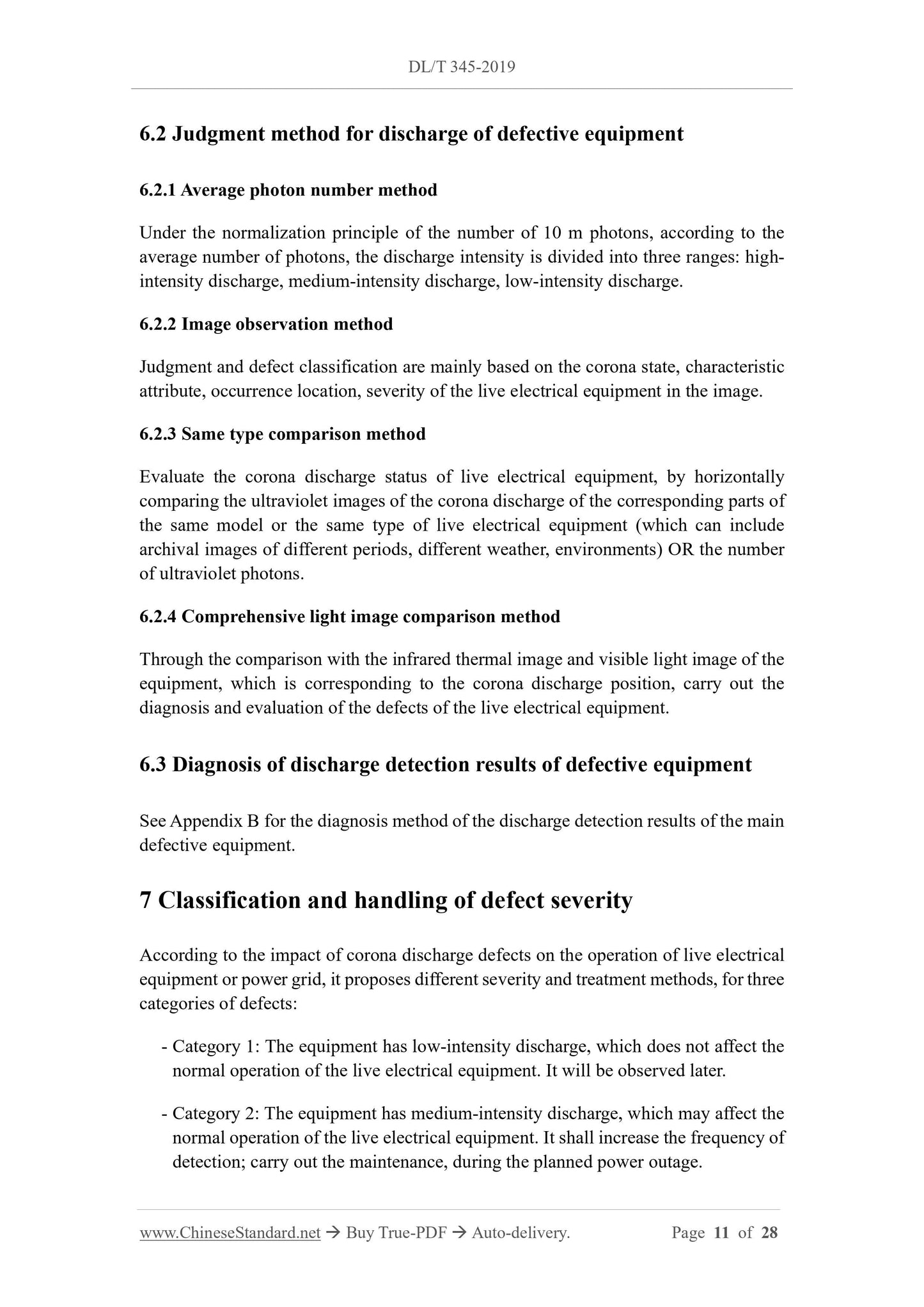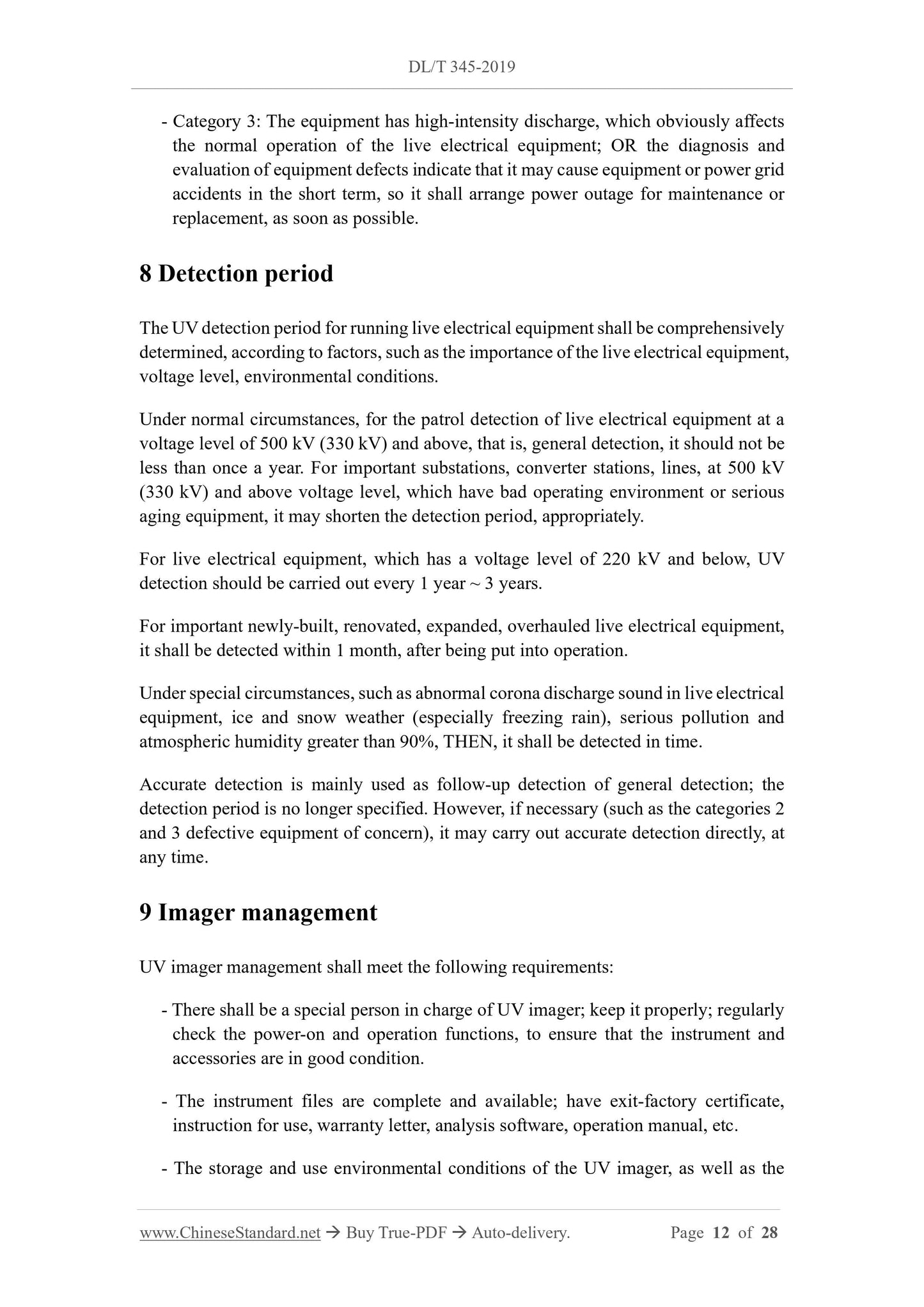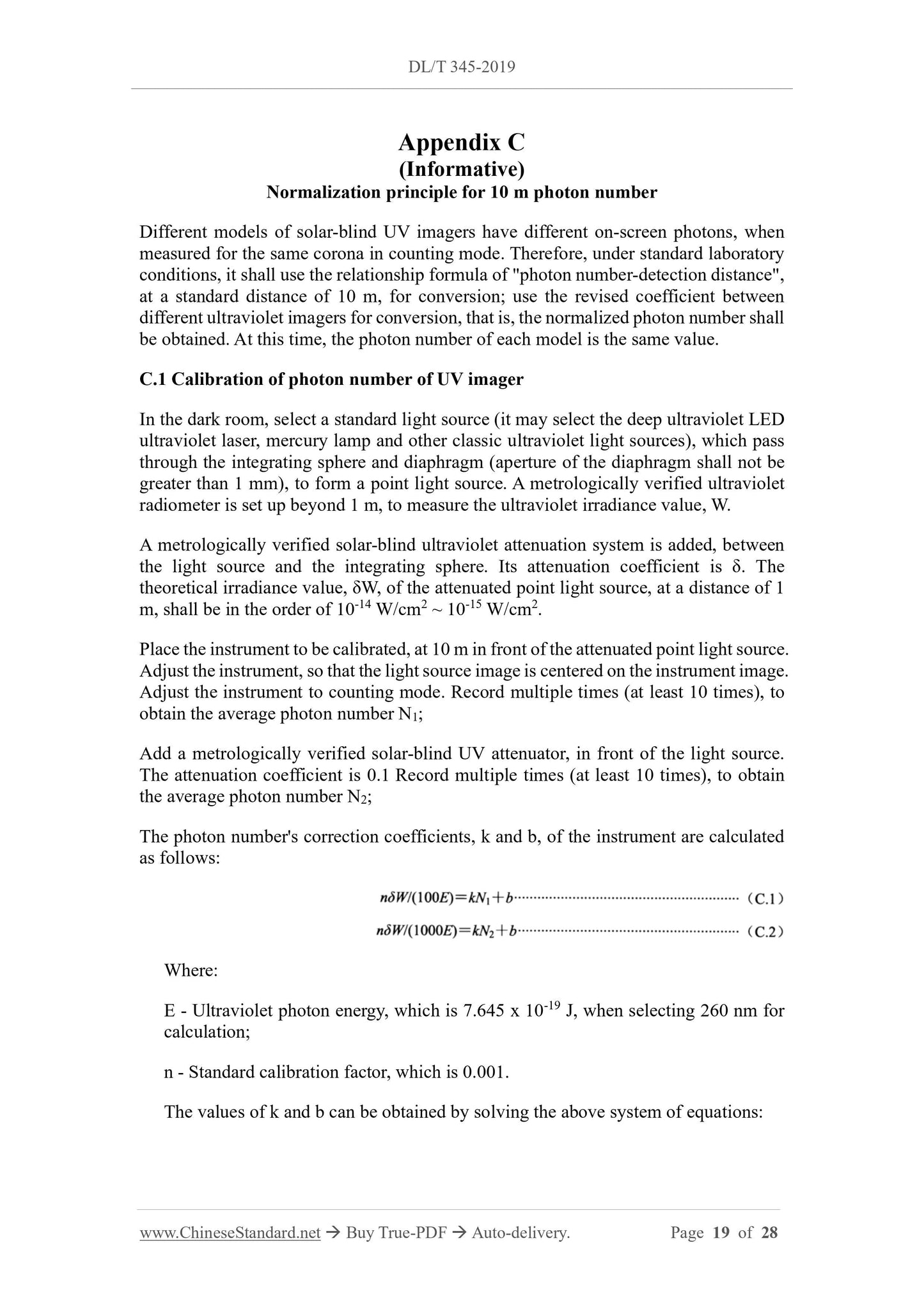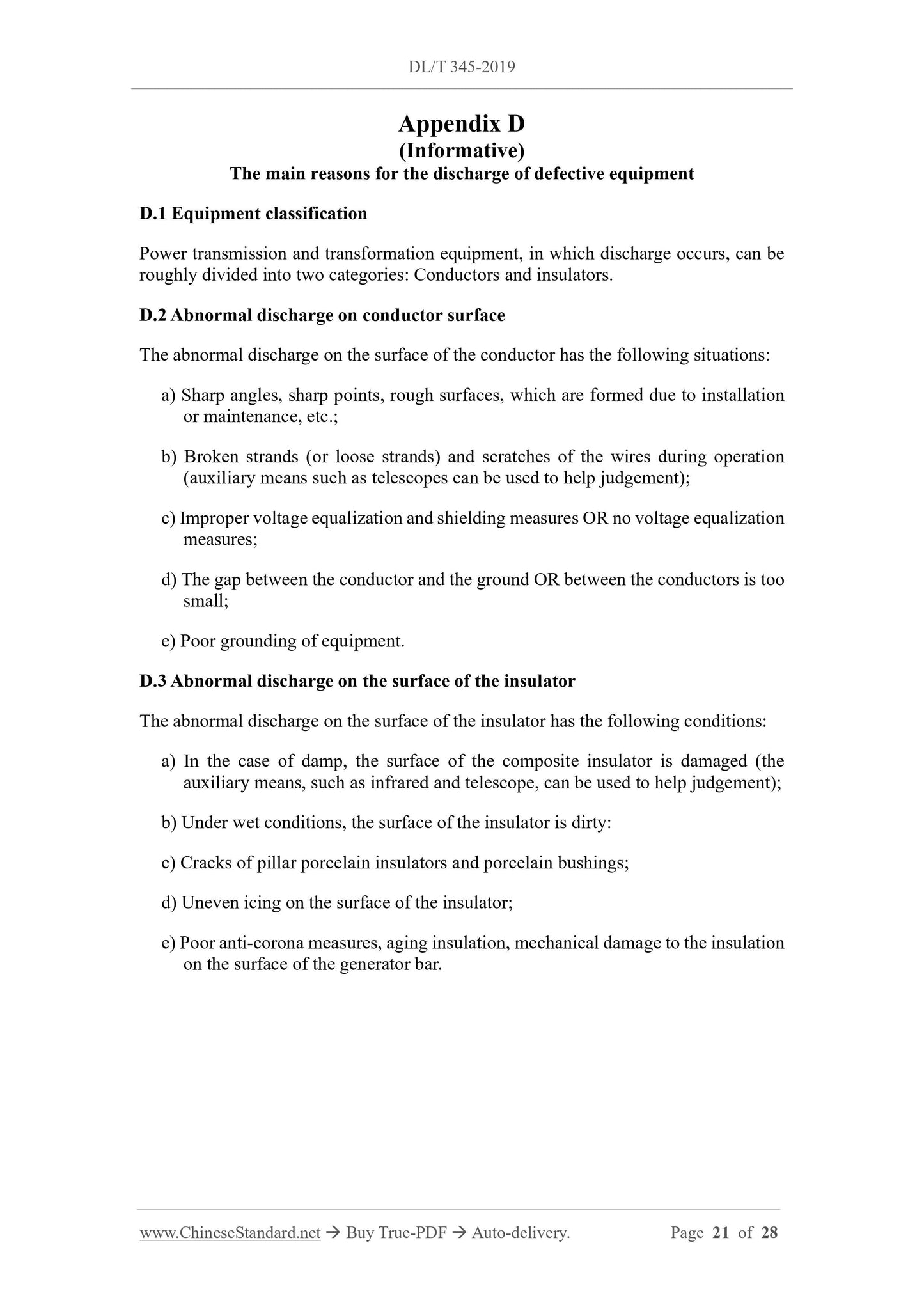1
/
of
10
PayPal, credit cards. Download editable-PDF and invoice in 1 second!
DL/T 345-2019 English PDF (DLT345-2019)
DL/T 345-2019 English PDF (DLT345-2019)
Regular price
$340.00 USD
Regular price
Sale price
$340.00 USD
Unit price
/
per
Shipping calculated at checkout.
Couldn't load pickup availability
Delivery: 3 seconds. Download true-PDF + Invoice.
Get QUOTATION in 1-minute: Click DL/T 345-2019
Historical versions: DL/T 345-2019
Preview True-PDF (Reload/Scroll if blank)
DL/T 345-2019: Application guidelines of UV diagnostic technology for live electrical equipment
DL/T 345-2019
DL
ELECTRICAL INDUSTRY STANDARD
OF THE PEOPLE’S REPUBLIC OF CHINA
ICS 29.240.20
F 23
Replacing DL/T 345-2010
Application guidelines of UV diagnostic technology for live
electrical equipment
ISSUED ON: NOVEMBER 04, 2019
IMPLEMENTED ON: MAY 01, 2020
Issued by: National Energy Administration
Table of Contents
Foreword ... 4
1 Scope ... 6
2 Normative references ... 6
3 Terms and definitions ... 6
4 On-site detection requirements ... 7
4.1 Personnel requirements ... 7
4.2 Safety requirements ... 8
4.3 Requirements for detection environmental conditions ... 8
4.4 Instrument requirements ... 8
5 Detection methods ... 9
5.1 General detection ... 9
5.2 Accurate detection ... 9
5.3 Main influencing factors of UV detection ... 10
6 Determination of discharge defect type and detection result diagnosis ... 10
6.1 The main reasons for the discharge of defective equipment ... 10
6.2 Judgment method for discharge of defective equipment ... 11
6.3 Diagnosis of discharge detection results of defective equipment ... 11
7 Classification and handling of defect severity ... 11
8 Detection period ... 12
9 Imager management ... 12
10 Detection data management ... 13
Appendix A (Informative) Identification of wind class and wind speed ... 14
Appendix B (Normative) Diagnosis of detection result of discharge from defective
equipment ... 15
Appendix C (Informative) Normalization principle for 10 m photon number ... 19
Appendix D (Informative) The main reasons for the discharge of defective equipment
... 21
Appendix E (Informative) Ultraviolet test report for live electrical equipment ... 22
Appendix F (Informative) Typical diagram of corona discharge for power transmission
and transformation equipment and generators ... 23
Application guidelines of UV diagnostic technology for live
electrical equipment
1 Scope
This standard specifies the on-site detection requirements, detection methods,
determination of discharge defect types and detection results diagnosis, defect severity's
classification and handling, detection cycle, instrument and data management
requirements, for the application of ultraviolet imaging technology, to the diagnosis of
corona discharge of live electrical equipment.
This standard applies to the corona discharge detection and defect diagnosis, for high-
voltage live electrical equipment (mainly including equipment conductors and insulator
surfaces), which is caused by various reasons, using an ultraviolet imager.
2 Normative references
The following documents are essential for the application of this document. For dated
references, only the dated version applies to this document. For undated references, the
latest edition (including all amendments) applies to this document.
GB 26859 Safety code of electric power industry - Part of electric lines
GB 26860 Safety code of electric power industry - Electric part of power plants and
transformer substations
DL/T 298 Guide for detection and evaluation of corona defects on stator winding
overhangs of generator
DL/T 1779 Specification of ultraviolet imager for corona discharge detection in high
voltage electrical equipments
3 Terms and definitions
The following terms and definitions apply to this document.
3.1
Gain
and work site.
4.2 Safety requirements
The safety requirements are as follows:
- It shall strictly comply with GB 26859 and GB 26860;
- It shall strictly abide by the patrol requirements of the power plant, substation
(converter station), line;
- There shall be a special person for monitoring.
4.3 Requirements for detection environmental conditions
4.3.1 General detection requirements
The general detection requirements are as follows:
- The equipment to be tested is a live electrical equipment; it shall avoid the
obstructions that affect the detection, as much as possible;
- Detection shall not be performed under severe weather and environmental
conditions (such as lightning, heavy rain, etc.);
- The wind class should not be higher than class 4. Please refer to Appendix A, for
the identification of wind class and wind speed.
4.3.2 Requirements for accurate detection
In addition to meeting the general detection requirements, the following requirements
shall also be met:
- The wind class should not be higher than class 3;
- Try to eliminate or reduce the influence of electromagnetic interference or other
factors, on the measurement of the instrument.
4.4 Instrument requirements
Meet the requirements of DL/T 1779 standard.
5 Detection methods
5.1 General detection
Turn on the UV imager. Set the appropriate gain, to make the image clear and stable.
Then start to conduct a large-area patrol inspection of the equipment and corona
discharge, to find out the equipment, parts and the intensity of the discharge.
5.2 Accurate detection
Accurately locate the discharge site. Obtain the visible light photos and discharge
characteristics of the discharge equipment, including the number of discharge photons,
discharge form, frequency and corona discharge intensity on the surface of the insulator,
etc. The requirements are as follows:
a) General requirements:
1) Within the range allowed by the safety distance, when the image content is
complete, the UV imager should be as close as possible to the detected
equipment, to maximize the corona discharge area of the detected equipment,
within the field of view; measure and record the distance from the UV imager
to the corona discharge area;
2) In the positioning of the discharge position, the UV imager shall select the
appropriate detection direction and angle, for the observation of the corona
discharge part, to avoid other equipment blocking and discharge interference;
3) Make judgement of discharge characteristics in combination with Appendix B;
4) During the detection process, it shall record the parameters, such as instrument
gain, ambient temperature/humidity, detection distance, focus state.
b) Recording of discharge pattern and frequency:
1) Adjust parameters such as instrument gain, to make the visual image clear. The
video recording time shall be able to fully describe the discharge process; the
recording time of the discharge phenomenon, at each point, shall not be less
than 5 s;
2) In the process of detecting the length form discharge, by detecting the range of
repeated occurrence of corona discharge on the outer insulation surface of the
equipment, estimate and record the remaining dry arc distance or the number
of insulator sheets and sheds;
6.2 Judgment method for discharge of defective equipment
6.2.1 Average photon number method
Under the normalization principle of the number of 10 m photons, according to the
average number of photons, the discharge intensity is divided into three ranges: high-
intensity discharge, medium-intensity discharge, low-intensity discharge.
6.2.2 Image observation method
Judgment and defect classification are mainly based on the corona state, characteristic
attribute, occurrence location, severity of the live electrical equipment in the image.
6.2.3 Same type comparison method
Evaluate the corona discharge status of live electrical equipment, by horizontally
comparing the ultraviolet images of the corona discharge of the corresponding parts of
the same model or the same type of live electrical equipment (which can include
archival images of different per...
Get QUOTATION in 1-minute: Click DL/T 345-2019
Historical versions: DL/T 345-2019
Preview True-PDF (Reload/Scroll if blank)
DL/T 345-2019: Application guidelines of UV diagnostic technology for live electrical equipment
DL/T 345-2019
DL
ELECTRICAL INDUSTRY STANDARD
OF THE PEOPLE’S REPUBLIC OF CHINA
ICS 29.240.20
F 23
Replacing DL/T 345-2010
Application guidelines of UV diagnostic technology for live
electrical equipment
ISSUED ON: NOVEMBER 04, 2019
IMPLEMENTED ON: MAY 01, 2020
Issued by: National Energy Administration
Table of Contents
Foreword ... 4
1 Scope ... 6
2 Normative references ... 6
3 Terms and definitions ... 6
4 On-site detection requirements ... 7
4.1 Personnel requirements ... 7
4.2 Safety requirements ... 8
4.3 Requirements for detection environmental conditions ... 8
4.4 Instrument requirements ... 8
5 Detection methods ... 9
5.1 General detection ... 9
5.2 Accurate detection ... 9
5.3 Main influencing factors of UV detection ... 10
6 Determination of discharge defect type and detection result diagnosis ... 10
6.1 The main reasons for the discharge of defective equipment ... 10
6.2 Judgment method for discharge of defective equipment ... 11
6.3 Diagnosis of discharge detection results of defective equipment ... 11
7 Classification and handling of defect severity ... 11
8 Detection period ... 12
9 Imager management ... 12
10 Detection data management ... 13
Appendix A (Informative) Identification of wind class and wind speed ... 14
Appendix B (Normative) Diagnosis of detection result of discharge from defective
equipment ... 15
Appendix C (Informative) Normalization principle for 10 m photon number ... 19
Appendix D (Informative) The main reasons for the discharge of defective equipment
... 21
Appendix E (Informative) Ultraviolet test report for live electrical equipment ... 22
Appendix F (Informative) Typical diagram of corona discharge for power transmission
and transformation equipment and generators ... 23
Application guidelines of UV diagnostic technology for live
electrical equipment
1 Scope
This standard specifies the on-site detection requirements, detection methods,
determination of discharge defect types and detection results diagnosis, defect severity's
classification and handling, detection cycle, instrument and data management
requirements, for the application of ultraviolet imaging technology, to the diagnosis of
corona discharge of live electrical equipment.
This standard applies to the corona discharge detection and defect diagnosis, for high-
voltage live electrical equipment (mainly including equipment conductors and insulator
surfaces), which is caused by various reasons, using an ultraviolet imager.
2 Normative references
The following documents are essential for the application of this document. For dated
references, only the dated version applies to this document. For undated references, the
latest edition (including all amendments) applies to this document.
GB 26859 Safety code of electric power industry - Part of electric lines
GB 26860 Safety code of electric power industry - Electric part of power plants and
transformer substations
DL/T 298 Guide for detection and evaluation of corona defects on stator winding
overhangs of generator
DL/T 1779 Specification of ultraviolet imager for corona discharge detection in high
voltage electrical equipments
3 Terms and definitions
The following terms and definitions apply to this document.
3.1
Gain
and work site.
4.2 Safety requirements
The safety requirements are as follows:
- It shall strictly comply with GB 26859 and GB 26860;
- It shall strictly abide by the patrol requirements of the power plant, substation
(converter station), line;
- There shall be a special person for monitoring.
4.3 Requirements for detection environmental conditions
4.3.1 General detection requirements
The general detection requirements are as follows:
- The equipment to be tested is a live electrical equipment; it shall avoid the
obstructions that affect the detection, as much as possible;
- Detection shall not be performed under severe weather and environmental
conditions (such as lightning, heavy rain, etc.);
- The wind class should not be higher than class 4. Please refer to Appendix A, for
the identification of wind class and wind speed.
4.3.2 Requirements for accurate detection
In addition to meeting the general detection requirements, the following requirements
shall also be met:
- The wind class should not be higher than class 3;
- Try to eliminate or reduce the influence of electromagnetic interference or other
factors, on the measurement of the instrument.
4.4 Instrument requirements
Meet the requirements of DL/T 1779 standard.
5 Detection methods
5.1 General detection
Turn on the UV imager. Set the appropriate gain, to make the image clear and stable.
Then start to conduct a large-area patrol inspection of the equipment and corona
discharge, to find out the equipment, parts and the intensity of the discharge.
5.2 Accurate detection
Accurately locate the discharge site. Obtain the visible light photos and discharge
characteristics of the discharge equipment, including the number of discharge photons,
discharge form, frequency and corona discharge intensity on the surface of the insulator,
etc. The requirements are as follows:
a) General requirements:
1) Within the range allowed by the safety distance, when the image content is
complete, the UV imager should be as close as possible to the detected
equipment, to maximize the corona discharge area of the detected equipment,
within the field of view; measure and record the distance from the UV imager
to the corona discharge area;
2) In the positioning of the discharge position, the UV imager shall select the
appropriate detection direction and angle, for the observation of the corona
discharge part, to avoid other equipment blocking and discharge interference;
3) Make judgement of discharge characteristics in combination with Appendix B;
4) During the detection process, it shall record the parameters, such as instrument
gain, ambient temperature/humidity, detection distance, focus state.
b) Recording of discharge pattern and frequency:
1) Adjust parameters such as instrument gain, to make the visual image clear. The
video recording time shall be able to fully describe the discharge process; the
recording time of the discharge phenomenon, at each point, shall not be less
than 5 s;
2) In the process of detecting the length form discharge, by detecting the range of
repeated occurrence of corona discharge on the outer insulation surface of the
equipment, estimate and record the remaining dry arc distance or the number
of insulator sheets and sheds;
6.2 Judgment method for discharge of defective equipment
6.2.1 Average photon number method
Under the normalization principle of the number of 10 m photons, according to the
average number of photons, the discharge intensity is divided into three ranges: high-
intensity discharge, medium-intensity discharge, low-intensity discharge.
6.2.2 Image observation method
Judgment and defect classification are mainly based on the corona state, characteristic
attribute, occurrence location, severity of the live electrical equipment in the image.
6.2.3 Same type comparison method
Evaluate the corona discharge status of live electrical equipment, by horizontally
comparing the ultraviolet images of the corona discharge of the corresponding parts of
the same model or the same type of live electrical equipment (which can include
archival images of different per...
Share
